MSc Accountancy: Credit Risk, Systemic Risk, Moral Hazards in Banking
VerifiedAdded on 2023/01/19
|18
|5188
|58
Report
AI Summary
This report provides an in-depth analysis of credit risk, systemic risk, and moral hazards within the banking industry. It examines the importance of credit risk management, including evaluation, analysis, and mitigation strategies. The report explores the factors contributing to systemic risk and the measures needed to reduce the banking sector's exposure. Furthermore, it discusses moral hazards and the regulatory changes necessary to ensure financial stability and capital adequacy, referencing key literature and statistical data to support its findings. The report highlights the vulnerabilities of the banking sector and suggests improvements in supervisory regulation to address these risks.
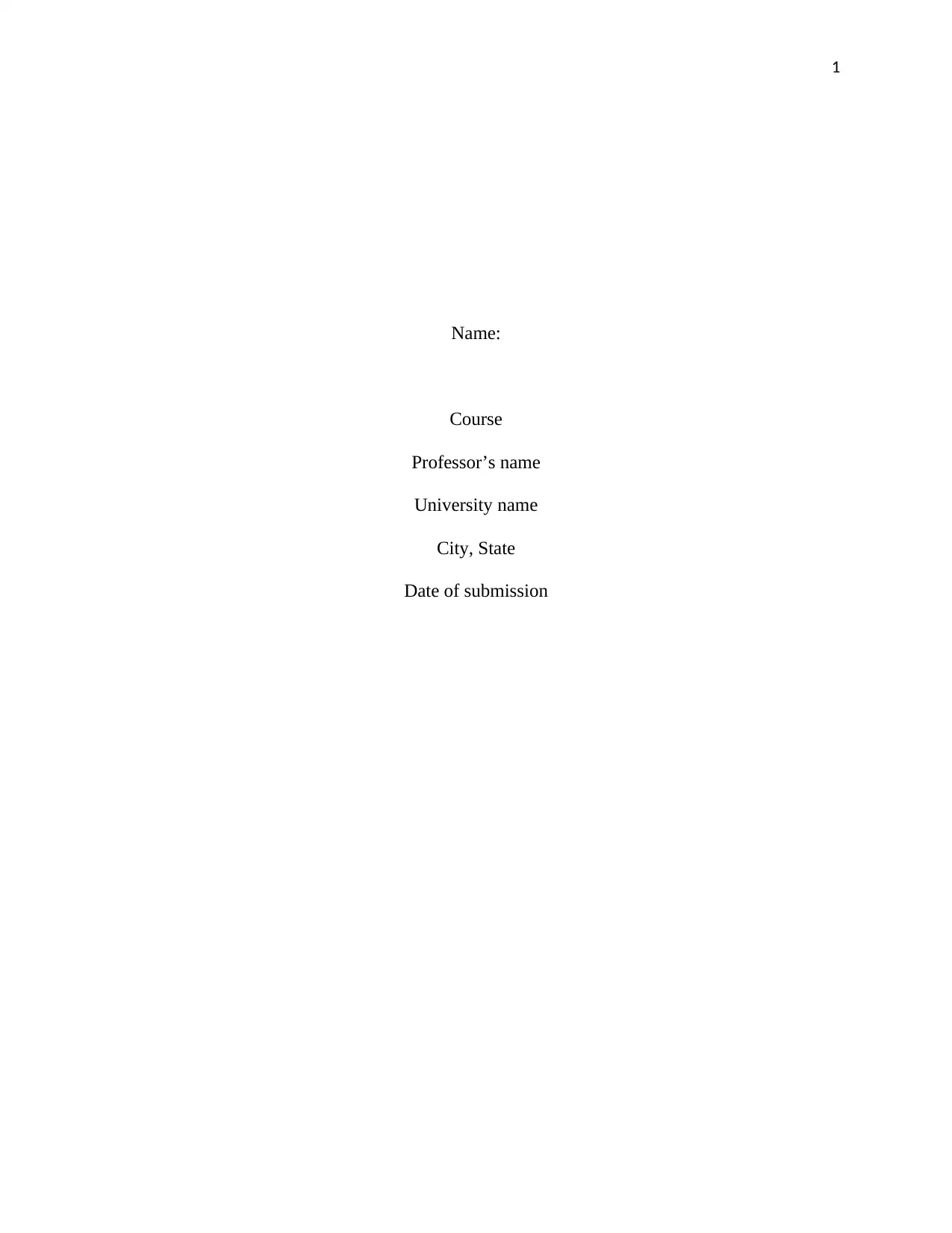
1
Name:
Course
Professor’s name
University name
City, State
Date of submission
Name:
Course
Professor’s name
University name
City, State
Date of submission
Paraphrase This Document
Need a fresh take? Get an instant paraphrase of this document with our AI Paraphraser
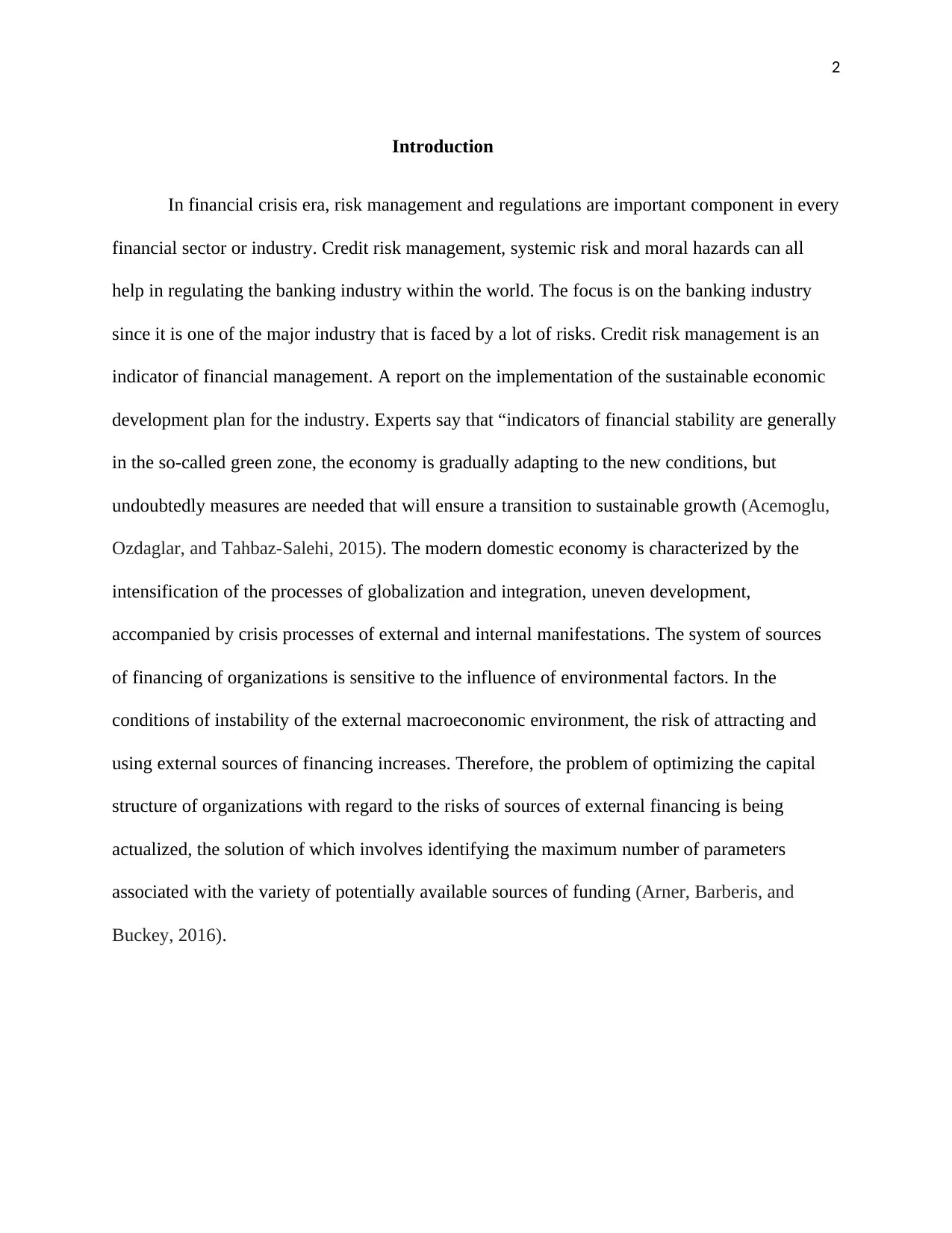
2
Introduction
In financial crisis era, risk management and regulations are important component in every
financial sector or industry. Credit risk management, systemic risk and moral hazards can all
help in regulating the banking industry within the world. The focus is on the banking industry
since it is one of the major industry that is faced by a lot of risks. Credit risk management is an
indicator of financial management. A report on the implementation of the sustainable economic
development plan for the industry. Experts say that “indicators of financial stability are generally
in the so-called green zone, the economy is gradually adapting to the new conditions, but
undoubtedly measures are needed that will ensure a transition to sustainable growth (Acemoglu,
Ozdaglar, and Tahbaz-Salehi, 2015). The modern domestic economy is characterized by the
intensification of the processes of globalization and integration, uneven development,
accompanied by crisis processes of external and internal manifestations. The system of sources
of financing of organizations is sensitive to the influence of environmental factors. In the
conditions of instability of the external macroeconomic environment, the risk of attracting and
using external sources of financing increases. Therefore, the problem of optimizing the capital
structure of organizations with regard to the risks of sources of external financing is being
actualized, the solution of which involves identifying the maximum number of parameters
associated with the variety of potentially available sources of funding (Arner, Barberis, and
Buckey, 2016).
Introduction
In financial crisis era, risk management and regulations are important component in every
financial sector or industry. Credit risk management, systemic risk and moral hazards can all
help in regulating the banking industry within the world. The focus is on the banking industry
since it is one of the major industry that is faced by a lot of risks. Credit risk management is an
indicator of financial management. A report on the implementation of the sustainable economic
development plan for the industry. Experts say that “indicators of financial stability are generally
in the so-called green zone, the economy is gradually adapting to the new conditions, but
undoubtedly measures are needed that will ensure a transition to sustainable growth (Acemoglu,
Ozdaglar, and Tahbaz-Salehi, 2015). The modern domestic economy is characterized by the
intensification of the processes of globalization and integration, uneven development,
accompanied by crisis processes of external and internal manifestations. The system of sources
of financing of organizations is sensitive to the influence of environmental factors. In the
conditions of instability of the external macroeconomic environment, the risk of attracting and
using external sources of financing increases. Therefore, the problem of optimizing the capital
structure of organizations with regard to the risks of sources of external financing is being
actualized, the solution of which involves identifying the maximum number of parameters
associated with the variety of potentially available sources of funding (Arner, Barberis, and
Buckey, 2016).
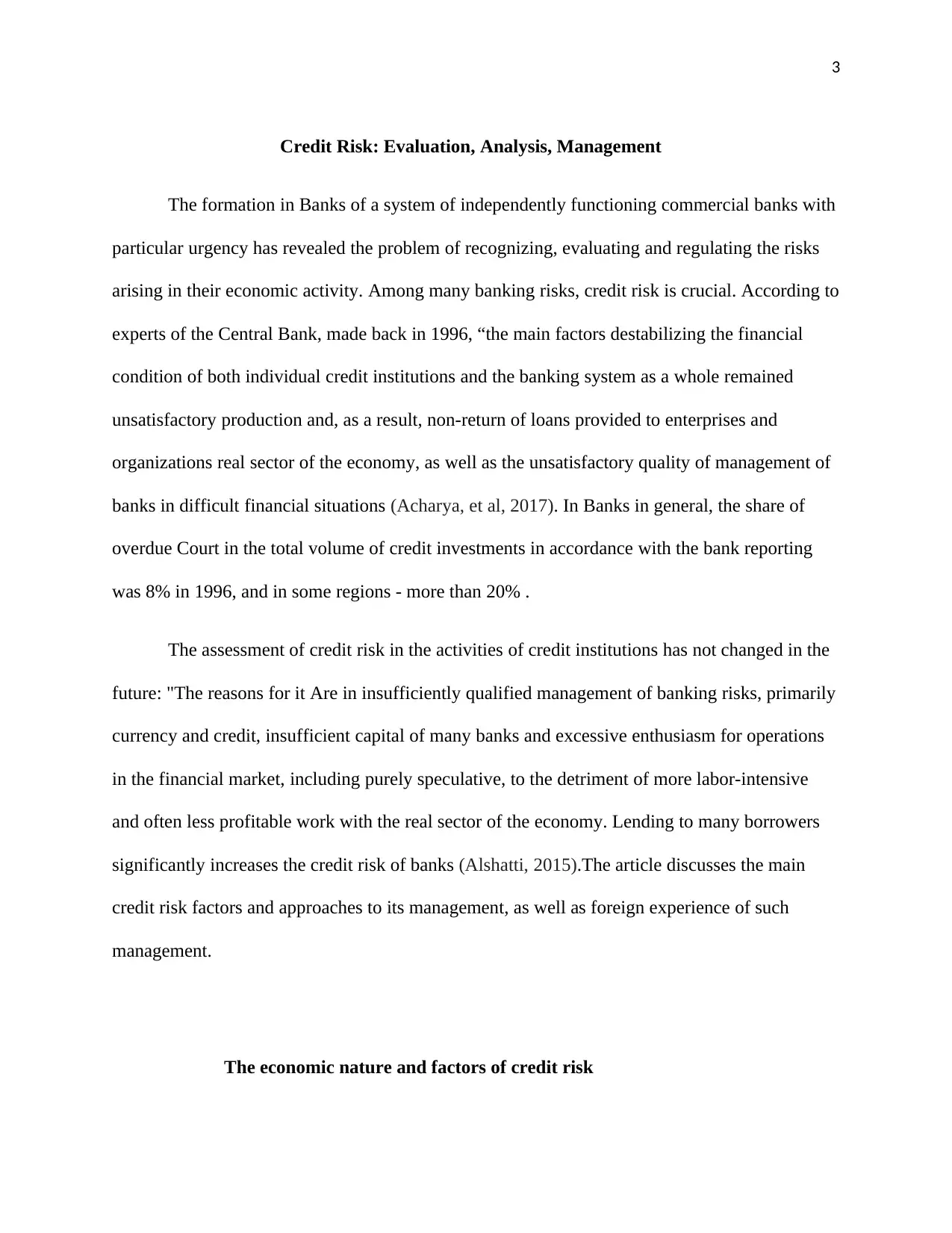
3
Credit Risk: Evaluation, Analysis, Management
The formation in Banks of a system of independently functioning commercial banks with
particular urgency has revealed the problem of recognizing, evaluating and regulating the risks
arising in their economic activity. Among many banking risks, credit risk is crucial. According to
experts of the Central Bank, made back in 1996, “the main factors destabilizing the financial
condition of both individual credit institutions and the banking system as a whole remained
unsatisfactory production and, as a result, non-return of loans provided to enterprises and
organizations real sector of the economy, as well as the unsatisfactory quality of management of
banks in difficult financial situations (Acharya, et al, 2017). In Banks in general, the share of
overdue Court in the total volume of credit investments in accordance with the bank reporting
was 8% in 1996, and in some regions - more than 20% .
The assessment of credit risk in the activities of credit institutions has not changed in the
future: "The reasons for it Are in insufficiently qualified management of banking risks, primarily
currency and credit, insufficient capital of many banks and excessive enthusiasm for operations
in the financial market, including purely speculative, to the detriment of more labor-intensive
and often less profitable work with the real sector of the economy. Lending to many borrowers
significantly increases the credit risk of banks (Alshatti, 2015).The article discusses the main
credit risk factors and approaches to its management, as well as foreign experience of such
management.
The economic nature and factors of credit risk
Credit Risk: Evaluation, Analysis, Management
The formation in Banks of a system of independently functioning commercial banks with
particular urgency has revealed the problem of recognizing, evaluating and regulating the risks
arising in their economic activity. Among many banking risks, credit risk is crucial. According to
experts of the Central Bank, made back in 1996, “the main factors destabilizing the financial
condition of both individual credit institutions and the banking system as a whole remained
unsatisfactory production and, as a result, non-return of loans provided to enterprises and
organizations real sector of the economy, as well as the unsatisfactory quality of management of
banks in difficult financial situations (Acharya, et al, 2017). In Banks in general, the share of
overdue Court in the total volume of credit investments in accordance with the bank reporting
was 8% in 1996, and in some regions - more than 20% .
The assessment of credit risk in the activities of credit institutions has not changed in the
future: "The reasons for it Are in insufficiently qualified management of banking risks, primarily
currency and credit, insufficient capital of many banks and excessive enthusiasm for operations
in the financial market, including purely speculative, to the detriment of more labor-intensive
and often less profitable work with the real sector of the economy. Lending to many borrowers
significantly increases the credit risk of banks (Alshatti, 2015).The article discusses the main
credit risk factors and approaches to its management, as well as foreign experience of such
management.
The economic nature and factors of credit risk
⊘ This is a preview!⊘
Do you want full access?
Subscribe today to unlock all pages.

Trusted by 1+ million students worldwide
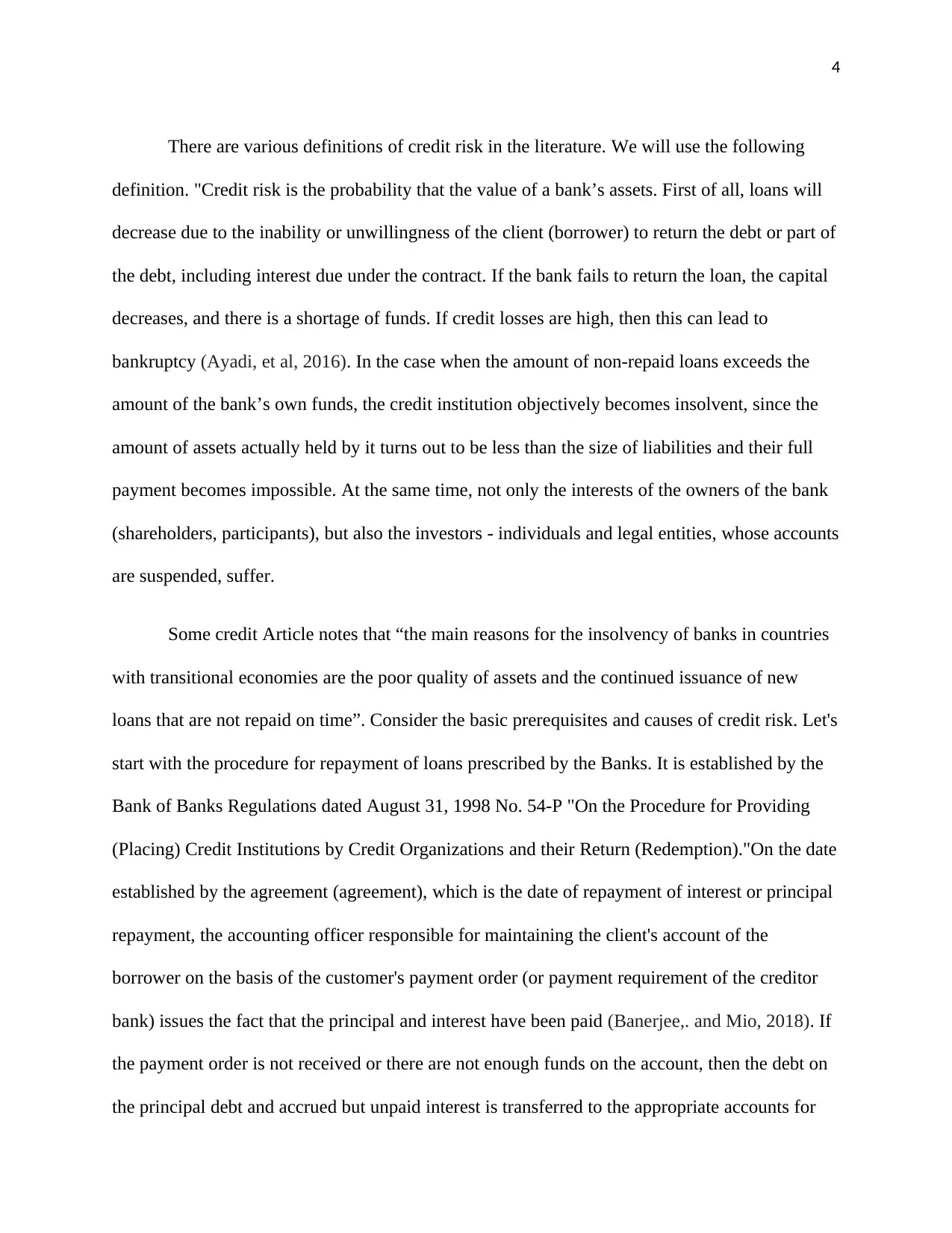
4
There are various definitions of credit risk in the literature. We will use the following
definition. "Credit risk is the probability that the value of a bank’s assets. First of all, loans will
decrease due to the inability or unwillingness of the client (borrower) to return the debt or part of
the debt, including interest due under the contract. If the bank fails to return the loan, the capital
decreases, and there is a shortage of funds. If credit losses are high, then this can lead to
bankruptcy (Ayadi, et al, 2016). In the case when the amount of non-repaid loans exceeds the
amount of the bank’s own funds, the credit institution objectively becomes insolvent, since the
amount of assets actually held by it turns out to be less than the size of liabilities and their full
payment becomes impossible. At the same time, not only the interests of the owners of the bank
(shareholders, participants), but also the investors - individuals and legal entities, whose accounts
are suspended, suffer.
Some credit Article notes that “the main reasons for the insolvency of banks in countries
with transitional economies are the poor quality of assets and the continued issuance of new
loans that are not repaid on time”. Consider the basic prerequisites and causes of credit risk. Let's
start with the procedure for repayment of loans prescribed by the Banks. It is established by the
Bank of Banks Regulations dated August 31, 1998 No. 54-P "On the Procedure for Providing
(Placing) Credit Institutions by Credit Organizations and their Return (Redemption)."On the date
established by the agreement (agreement), which is the date of repayment of interest or principal
repayment, the accounting officer responsible for maintaining the client's account of the
borrower on the basis of the customer's payment order (or payment requirement of the creditor
bank) issues the fact that the principal and interest have been paid (Banerjee,. and Mio, 2018). If
the payment order is not received or there are not enough funds on the account, then the debt on
the principal debt and accrued but unpaid interest is transferred to the appropriate accounts for
There are various definitions of credit risk in the literature. We will use the following
definition. "Credit risk is the probability that the value of a bank’s assets. First of all, loans will
decrease due to the inability or unwillingness of the client (borrower) to return the debt or part of
the debt, including interest due under the contract. If the bank fails to return the loan, the capital
decreases, and there is a shortage of funds. If credit losses are high, then this can lead to
bankruptcy (Ayadi, et al, 2016). In the case when the amount of non-repaid loans exceeds the
amount of the bank’s own funds, the credit institution objectively becomes insolvent, since the
amount of assets actually held by it turns out to be less than the size of liabilities and their full
payment becomes impossible. At the same time, not only the interests of the owners of the bank
(shareholders, participants), but also the investors - individuals and legal entities, whose accounts
are suspended, suffer.
Some credit Article notes that “the main reasons for the insolvency of banks in countries
with transitional economies are the poor quality of assets and the continued issuance of new
loans that are not repaid on time”. Consider the basic prerequisites and causes of credit risk. Let's
start with the procedure for repayment of loans prescribed by the Banks. It is established by the
Bank of Banks Regulations dated August 31, 1998 No. 54-P "On the Procedure for Providing
(Placing) Credit Institutions by Credit Organizations and their Return (Redemption)."On the date
established by the agreement (agreement), which is the date of repayment of interest or principal
repayment, the accounting officer responsible for maintaining the client's account of the
borrower on the basis of the customer's payment order (or payment requirement of the creditor
bank) issues the fact that the principal and interest have been paid (Banerjee,. and Mio, 2018). If
the payment order is not received or there are not enough funds on the account, then the debt on
the principal debt and accrued but unpaid interest is transferred to the appropriate accounts for
Paraphrase This Document
Need a fresh take? Get an instant paraphrase of this document with our AI Paraphraser
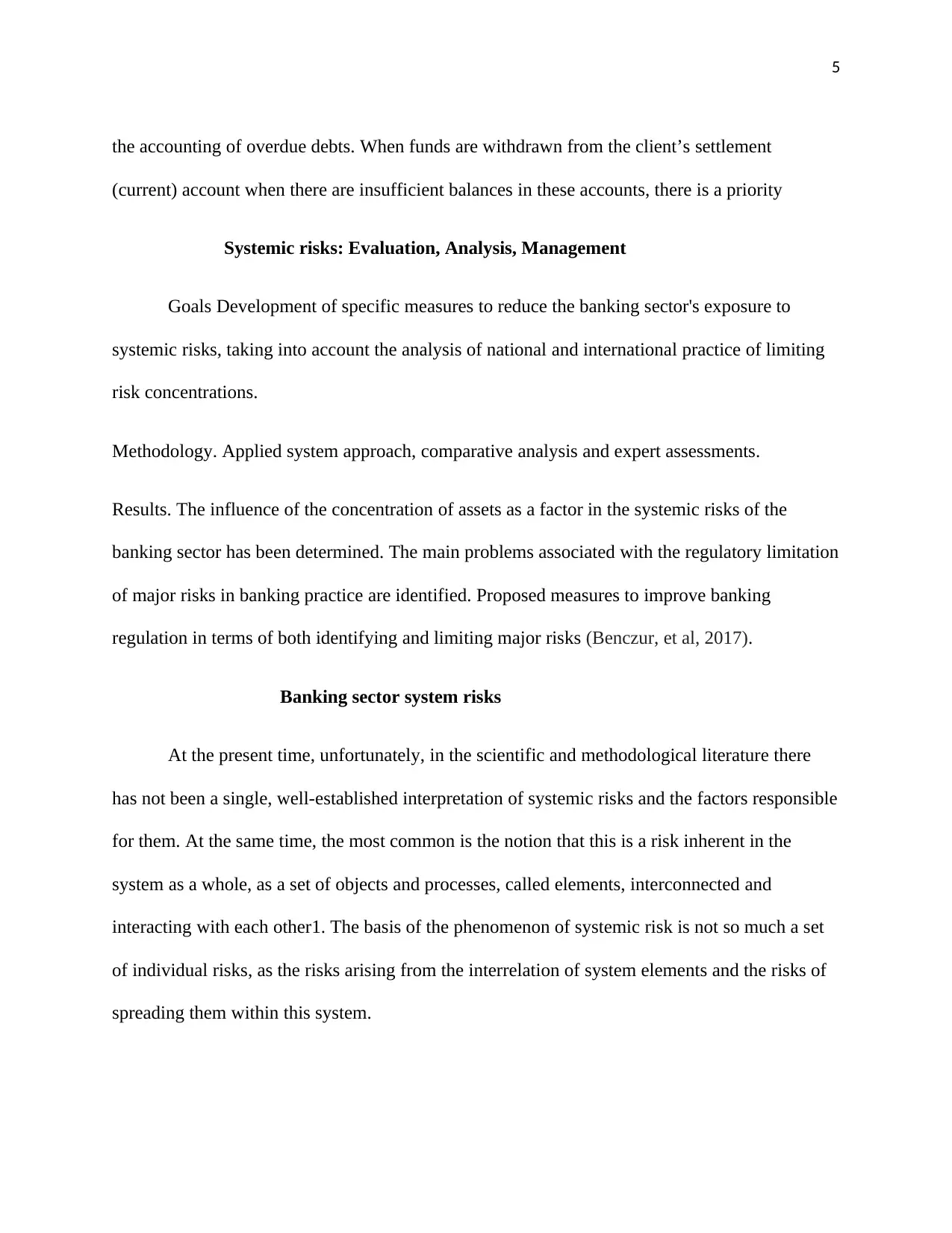
5
the accounting of overdue debts. When funds are withdrawn from the client’s settlement
(current) account when there are insufficient balances in these accounts, there is a priority
Systemic risks: Evaluation, Analysis, Management
Goals Development of specific measures to reduce the banking sector's exposure to
systemic risks, taking into account the analysis of national and international practice of limiting
risk concentrations.
Methodology. Applied system approach, comparative analysis and expert assessments.
Results. The influence of the concentration of assets as a factor in the systemic risks of the
banking sector has been determined. The main problems associated with the regulatory limitation
of major risks in banking practice are identified. Proposed measures to improve banking
regulation in terms of both identifying and limiting major risks (Benczur, et al, 2017).
Banking sector system risks
At the present time, unfortunately, in the scientific and methodological literature there
has not been a single, well-established interpretation of systemic risks and the factors responsible
for them. At the same time, the most common is the notion that this is a risk inherent in the
system as a whole, as a set of objects and processes, called elements, interconnected and
interacting with each other1. The basis of the phenomenon of systemic risk is not so much a set
of individual risks, as the risks arising from the interrelation of system elements and the risks of
spreading them within this system.
the accounting of overdue debts. When funds are withdrawn from the client’s settlement
(current) account when there are insufficient balances in these accounts, there is a priority
Systemic risks: Evaluation, Analysis, Management
Goals Development of specific measures to reduce the banking sector's exposure to
systemic risks, taking into account the analysis of national and international practice of limiting
risk concentrations.
Methodology. Applied system approach, comparative analysis and expert assessments.
Results. The influence of the concentration of assets as a factor in the systemic risks of the
banking sector has been determined. The main problems associated with the regulatory limitation
of major risks in banking practice are identified. Proposed measures to improve banking
regulation in terms of both identifying and limiting major risks (Benczur, et al, 2017).
Banking sector system risks
At the present time, unfortunately, in the scientific and methodological literature there
has not been a single, well-established interpretation of systemic risks and the factors responsible
for them. At the same time, the most common is the notion that this is a risk inherent in the
system as a whole, as a set of objects and processes, called elements, interconnected and
interacting with each other1. The basis of the phenomenon of systemic risk is not so much a set
of individual risks, as the risks arising from the interrelation of system elements and the risks of
spreading them within this system.
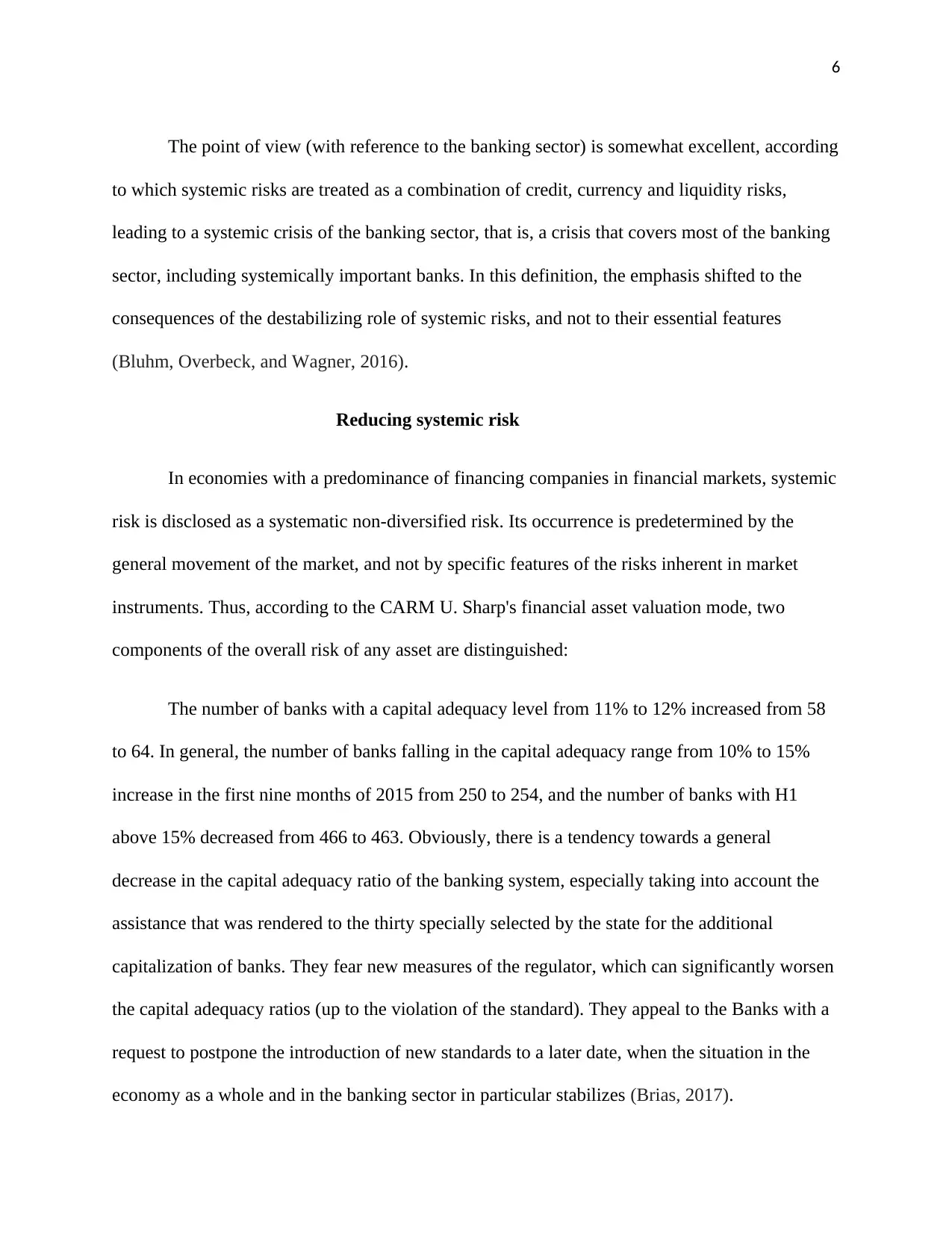
6
The point of view (with reference to the banking sector) is somewhat excellent, according
to which systemic risks are treated as a combination of credit, currency and liquidity risks,
leading to a systemic crisis of the banking sector, that is, a crisis that covers most of the banking
sector, including systemically important banks. In this definition, the emphasis shifted to the
consequences of the destabilizing role of systemic risks, and not to their essential features
(Bluhm, Overbeck, and Wagner, 2016).
Reducing systemic risk
In economies with a predominance of financing companies in financial markets, systemic
risk is disclosed as a systematic non-diversified risk. Its occurrence is predetermined by the
general movement of the market, and not by specific features of the risks inherent in market
instruments. Thus, according to the CARM U. Sharp's financial asset valuation mode, two
components of the overall risk of any asset are distinguished:
The number of banks with a capital adequacy level from 11% to 12% increased from 58
to 64. In general, the number of banks falling in the capital adequacy range from 10% to 15%
increase in the first nine months of 2015 from 250 to 254, and the number of banks with H1
above 15% decreased from 466 to 463. Obviously, there is a tendency towards a general
decrease in the capital adequacy ratio of the banking system, especially taking into account the
assistance that was rendered to the thirty specially selected by the state for the additional
capitalization of banks. They fear new measures of the regulator, which can significantly worsen
the capital adequacy ratios (up to the violation of the standard). They appeal to the Banks with a
request to postpone the introduction of new standards to a later date, when the situation in the
economy as a whole and in the banking sector in particular stabilizes (Brias, 2017).
The point of view (with reference to the banking sector) is somewhat excellent, according
to which systemic risks are treated as a combination of credit, currency and liquidity risks,
leading to a systemic crisis of the banking sector, that is, a crisis that covers most of the banking
sector, including systemically important banks. In this definition, the emphasis shifted to the
consequences of the destabilizing role of systemic risks, and not to their essential features
(Bluhm, Overbeck, and Wagner, 2016).
Reducing systemic risk
In economies with a predominance of financing companies in financial markets, systemic
risk is disclosed as a systematic non-diversified risk. Its occurrence is predetermined by the
general movement of the market, and not by specific features of the risks inherent in market
instruments. Thus, according to the CARM U. Sharp's financial asset valuation mode, two
components of the overall risk of any asset are distinguished:
The number of banks with a capital adequacy level from 11% to 12% increased from 58
to 64. In general, the number of banks falling in the capital adequacy range from 10% to 15%
increase in the first nine months of 2015 from 250 to 254, and the number of banks with H1
above 15% decreased from 466 to 463. Obviously, there is a tendency towards a general
decrease in the capital adequacy ratio of the banking system, especially taking into account the
assistance that was rendered to the thirty specially selected by the state for the additional
capitalization of banks. They fear new measures of the regulator, which can significantly worsen
the capital adequacy ratios (up to the violation of the standard). They appeal to the Banks with a
request to postpone the introduction of new standards to a later date, when the situation in the
economy as a whole and in the banking sector in particular stabilizes (Brias, 2017).
⊘ This is a preview!⊘
Do you want full access?
Subscribe today to unlock all pages.

Trusted by 1+ million students worldwide
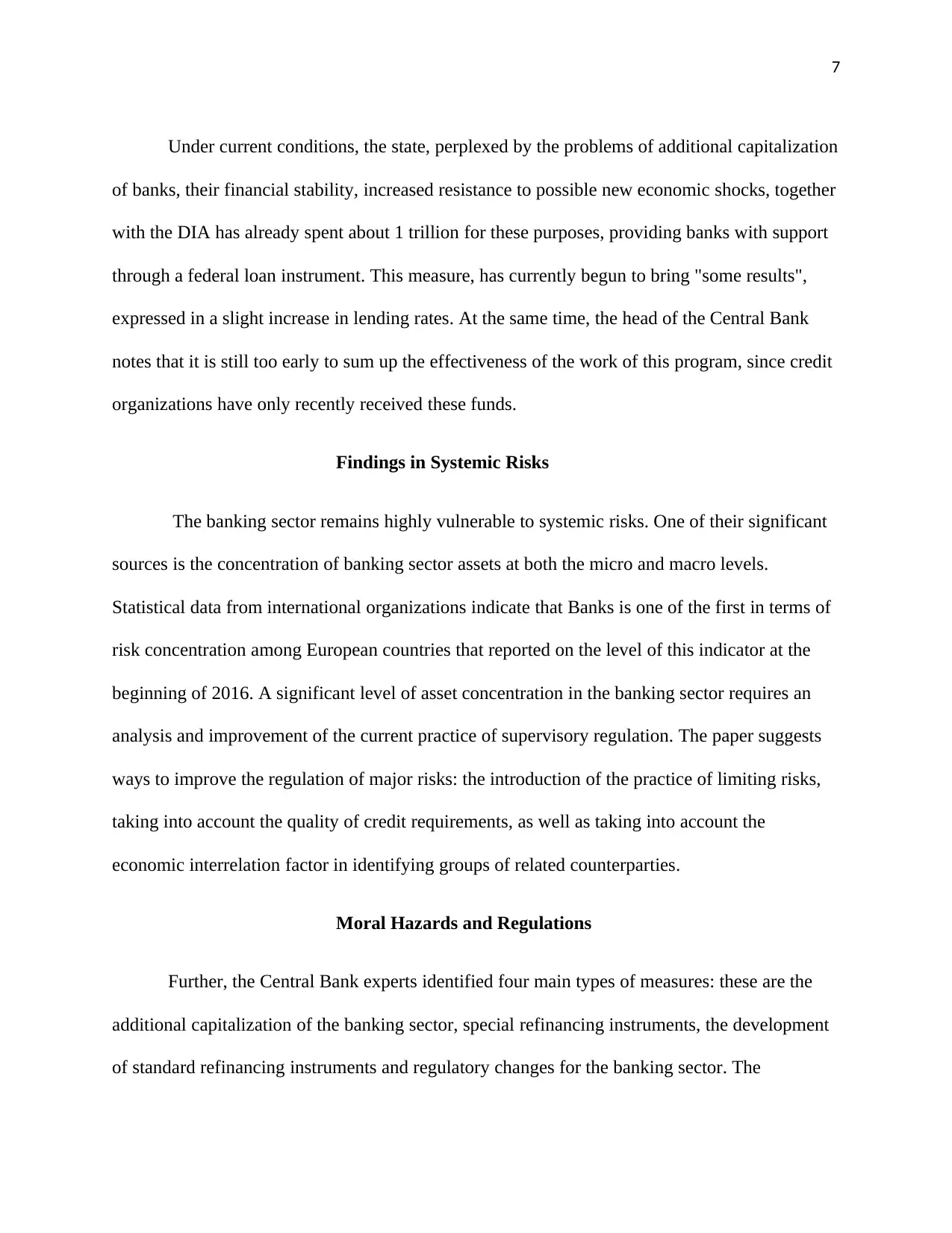
7
Under current conditions, the state, perplexed by the problems of additional capitalization
of banks, their financial stability, increased resistance to possible new economic shocks, together
with the DIA has already spent about 1 trillion for these purposes, providing banks with support
through a federal loan instrument. This measure, has currently begun to bring "some results",
expressed in a slight increase in lending rates. At the same time, the head of the Central Bank
notes that it is still too early to sum up the effectiveness of the work of this program, since credit
organizations have only recently received these funds.
Findings in Systemic Risks
The banking sector remains highly vulnerable to systemic risks. One of their significant
sources is the concentration of banking sector assets at both the micro and macro levels.
Statistical data from international organizations indicate that Banks is one of the first in terms of
risk concentration among European countries that reported on the level of this indicator at the
beginning of 2016. A significant level of asset concentration in the banking sector requires an
analysis and improvement of the current practice of supervisory regulation. The paper suggests
ways to improve the regulation of major risks: the introduction of the practice of limiting risks,
taking into account the quality of credit requirements, as well as taking into account the
economic interrelation factor in identifying groups of related counterparties.
Moral Hazards and Regulations
Further, the Central Bank experts identified four main types of measures: these are the
additional capitalization of the banking sector, special refinancing instruments, the development
of standard refinancing instruments and regulatory changes for the banking sector. The
Under current conditions, the state, perplexed by the problems of additional capitalization
of banks, their financial stability, increased resistance to possible new economic shocks, together
with the DIA has already spent about 1 trillion for these purposes, providing banks with support
through a federal loan instrument. This measure, has currently begun to bring "some results",
expressed in a slight increase in lending rates. At the same time, the head of the Central Bank
notes that it is still too early to sum up the effectiveness of the work of this program, since credit
organizations have only recently received these funds.
Findings in Systemic Risks
The banking sector remains highly vulnerable to systemic risks. One of their significant
sources is the concentration of banking sector assets at both the micro and macro levels.
Statistical data from international organizations indicate that Banks is one of the first in terms of
risk concentration among European countries that reported on the level of this indicator at the
beginning of 2016. A significant level of asset concentration in the banking sector requires an
analysis and improvement of the current practice of supervisory regulation. The paper suggests
ways to improve the regulation of major risks: the introduction of the practice of limiting risks,
taking into account the quality of credit requirements, as well as taking into account the
economic interrelation factor in identifying groups of related counterparties.
Moral Hazards and Regulations
Further, the Central Bank experts identified four main types of measures: these are the
additional capitalization of the banking sector, special refinancing instruments, the development
of standard refinancing instruments and regulatory changes for the banking sector. The
Paraphrase This Document
Need a fresh take? Get an instant paraphrase of this document with our AI Paraphraser
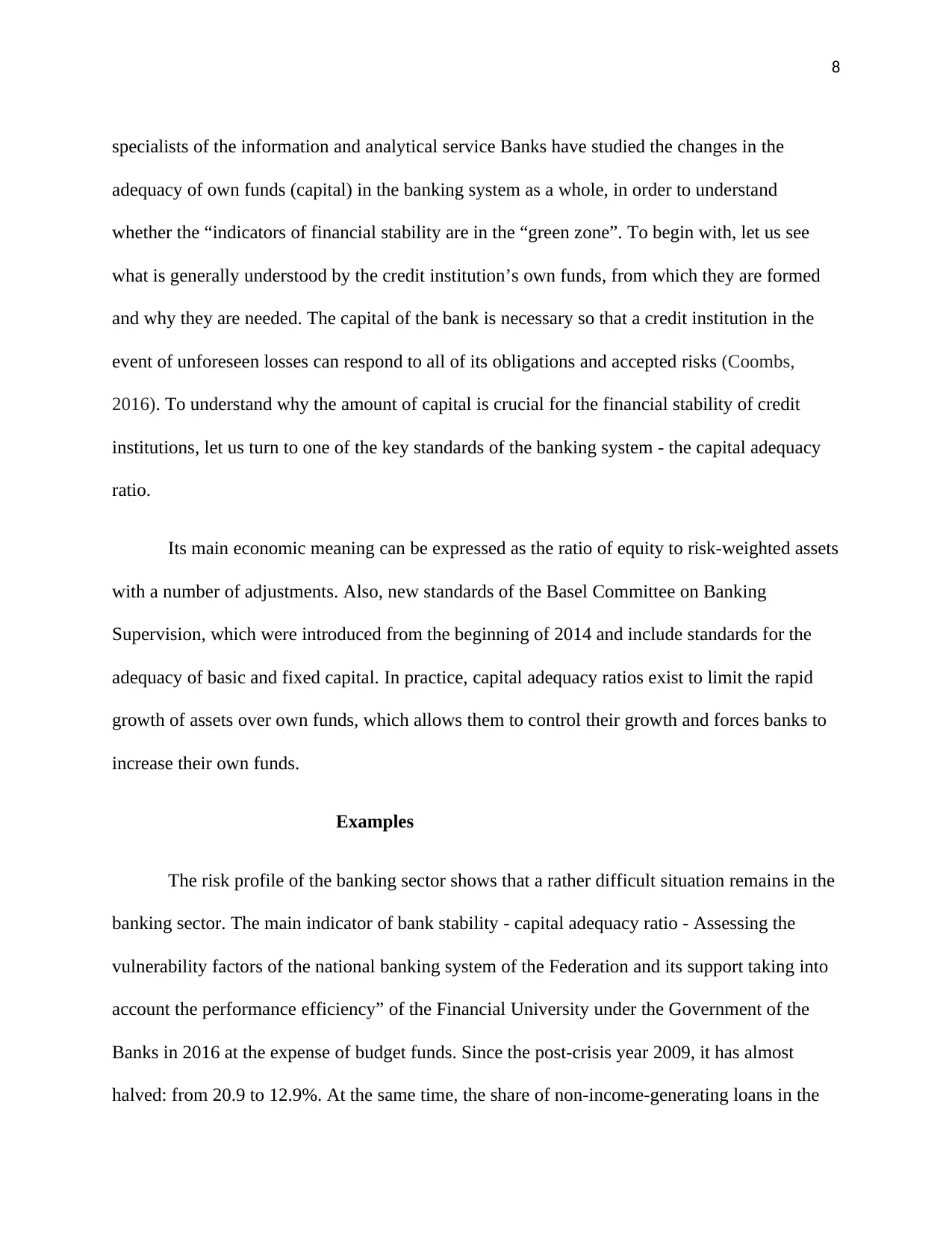
8
specialists of the information and analytical service Banks have studied the changes in the
adequacy of own funds (capital) in the banking system as a whole, in order to understand
whether the “indicators of financial stability are in the “green zone”. To begin with, let us see
what is generally understood by the credit institution’s own funds, from which they are formed
and why they are needed. The capital of the bank is necessary so that a credit institution in the
event of unforeseen losses can respond to all of its obligations and accepted risks (Coombs,
2016). To understand why the amount of capital is crucial for the financial stability of credit
institutions, let us turn to one of the key standards of the banking system - the capital adequacy
ratio.
Its main economic meaning can be expressed as the ratio of equity to risk-weighted assets
with a number of adjustments. Also, new standards of the Basel Committee on Banking
Supervision, which were introduced from the beginning of 2014 and include standards for the
adequacy of basic and fixed capital. In practice, capital adequacy ratios exist to limit the rapid
growth of assets over own funds, which allows them to control their growth and forces banks to
increase their own funds.
Examples
The risk profile of the banking sector shows that a rather difficult situation remains in the
banking sector. The main indicator of bank stability - capital adequacy ratio - Assessing the
vulnerability factors of the national banking system of the Federation and its support taking into
account the performance efficiency” of the Financial University under the Government of the
Banks in 2016 at the expense of budget funds. Since the post-crisis year 2009, it has almost
halved: from 20.9 to 12.9%. At the same time, the share of non-income-generating loans in the
specialists of the information and analytical service Banks have studied the changes in the
adequacy of own funds (capital) in the banking system as a whole, in order to understand
whether the “indicators of financial stability are in the “green zone”. To begin with, let us see
what is generally understood by the credit institution’s own funds, from which they are formed
and why they are needed. The capital of the bank is necessary so that a credit institution in the
event of unforeseen losses can respond to all of its obligations and accepted risks (Coombs,
2016). To understand why the amount of capital is crucial for the financial stability of credit
institutions, let us turn to one of the key standards of the banking system - the capital adequacy
ratio.
Its main economic meaning can be expressed as the ratio of equity to risk-weighted assets
with a number of adjustments. Also, new standards of the Basel Committee on Banking
Supervision, which were introduced from the beginning of 2014 and include standards for the
adequacy of basic and fixed capital. In practice, capital adequacy ratios exist to limit the rapid
growth of assets over own funds, which allows them to control their growth and forces banks to
increase their own funds.
Examples
The risk profile of the banking sector shows that a rather difficult situation remains in the
banking sector. The main indicator of bank stability - capital adequacy ratio - Assessing the
vulnerability factors of the national banking system of the Federation and its support taking into
account the performance efficiency” of the Financial University under the Government of the
Banks in 2016 at the expense of budget funds. Since the post-crisis year 2009, it has almost
halved: from 20.9 to 12.9%. At the same time, the share of non-income-generating loans in the
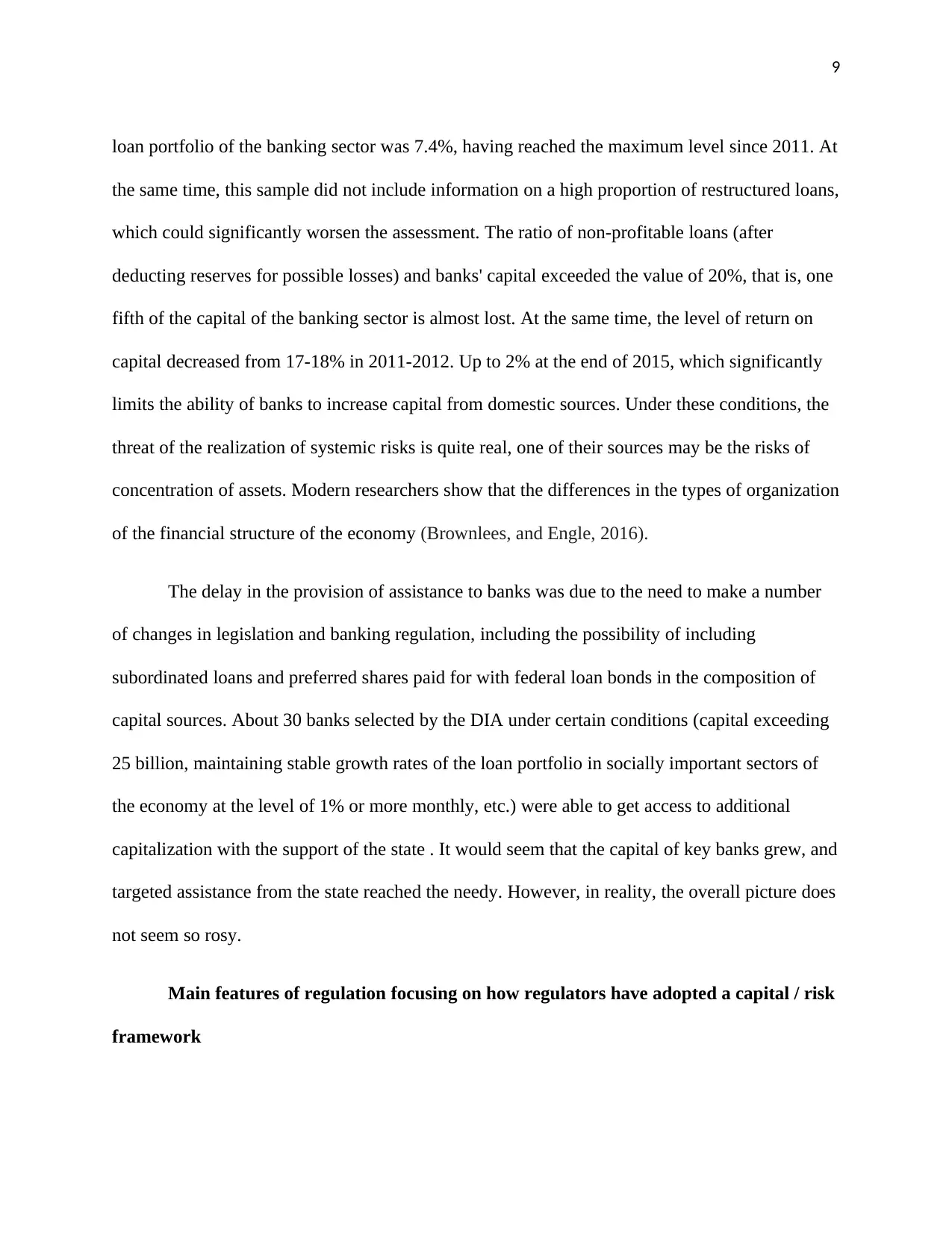
9
loan portfolio of the banking sector was 7.4%, having reached the maximum level since 2011. At
the same time, this sample did not include information on a high proportion of restructured loans,
which could significantly worsen the assessment. The ratio of non-profitable loans (after
deducting reserves for possible losses) and banks' capital exceeded the value of 20%, that is, one
fifth of the capital of the banking sector is almost lost. At the same time, the level of return on
capital decreased from 17-18% in 2011-2012. Up to 2% at the end of 2015, which significantly
limits the ability of banks to increase capital from domestic sources. Under these conditions, the
threat of the realization of systemic risks is quite real, one of their sources may be the risks of
concentration of assets. Modern researchers show that the differences in the types of organization
of the financial structure of the economy (Brownlees, and Engle, 2016).
The delay in the provision of assistance to banks was due to the need to make a number
of changes in legislation and banking regulation, including the possibility of including
subordinated loans and preferred shares paid for with federal loan bonds in the composition of
capital sources. About 30 banks selected by the DIA under certain conditions (capital exceeding
25 billion, maintaining stable growth rates of the loan portfolio in socially important sectors of
the economy at the level of 1% or more monthly, etc.) were able to get access to additional
capitalization with the support of the state . It would seem that the capital of key banks grew, and
targeted assistance from the state reached the needy. However, in reality, the overall picture does
not seem so rosy.
Main features of regulation focusing on how regulators have adopted a capital / risk
framework
loan portfolio of the banking sector was 7.4%, having reached the maximum level since 2011. At
the same time, this sample did not include information on a high proportion of restructured loans,
which could significantly worsen the assessment. The ratio of non-profitable loans (after
deducting reserves for possible losses) and banks' capital exceeded the value of 20%, that is, one
fifth of the capital of the banking sector is almost lost. At the same time, the level of return on
capital decreased from 17-18% in 2011-2012. Up to 2% at the end of 2015, which significantly
limits the ability of banks to increase capital from domestic sources. Under these conditions, the
threat of the realization of systemic risks is quite real, one of their sources may be the risks of
concentration of assets. Modern researchers show that the differences in the types of organization
of the financial structure of the economy (Brownlees, and Engle, 2016).
The delay in the provision of assistance to banks was due to the need to make a number
of changes in legislation and banking regulation, including the possibility of including
subordinated loans and preferred shares paid for with federal loan bonds in the composition of
capital sources. About 30 banks selected by the DIA under certain conditions (capital exceeding
25 billion, maintaining stable growth rates of the loan portfolio in socially important sectors of
the economy at the level of 1% or more monthly, etc.) were able to get access to additional
capitalization with the support of the state . It would seem that the capital of key banks grew, and
targeted assistance from the state reached the needy. However, in reality, the overall picture does
not seem so rosy.
Main features of regulation focusing on how regulators have adopted a capital / risk
framework
⊘ This is a preview!⊘
Do you want full access?
Subscribe today to unlock all pages.

Trusted by 1+ million students worldwide
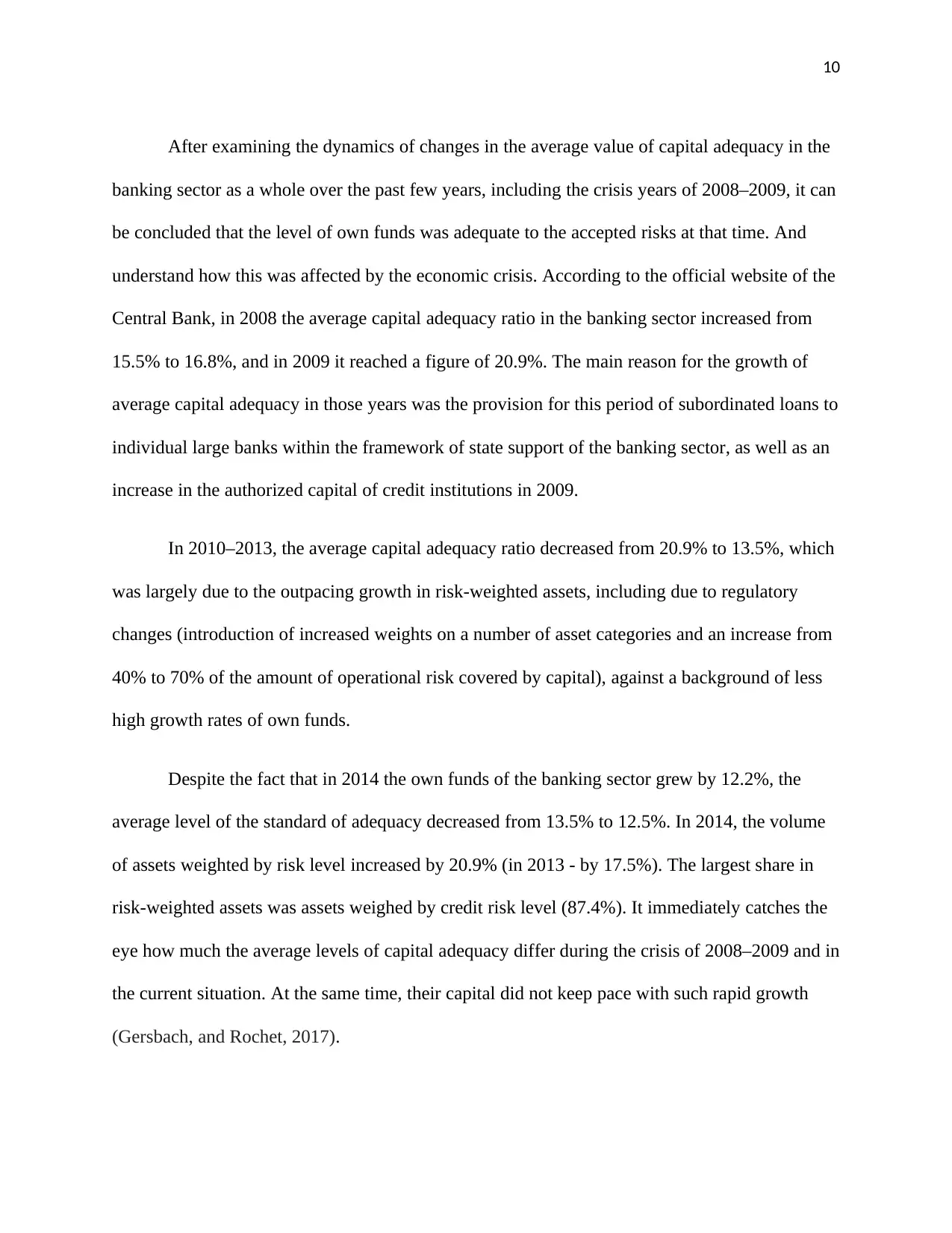
10
After examining the dynamics of changes in the average value of capital adequacy in the
banking sector as a whole over the past few years, including the crisis years of 2008–2009, it can
be concluded that the level of own funds was adequate to the accepted risks at that time. And
understand how this was affected by the economic crisis. According to the official website of the
Central Bank, in 2008 the average capital adequacy ratio in the banking sector increased from
15.5% to 16.8%, and in 2009 it reached a figure of 20.9%. The main reason for the growth of
average capital adequacy in those years was the provision for this period of subordinated loans to
individual large banks within the framework of state support of the banking sector, as well as an
increase in the authorized capital of credit institutions in 2009.
In 2010–2013, the average capital adequacy ratio decreased from 20.9% to 13.5%, which
was largely due to the outpacing growth in risk-weighted assets, including due to regulatory
changes (introduction of increased weights on a number of asset categories and an increase from
40% to 70% of the amount of operational risk covered by capital), against a background of less
high growth rates of own funds.
Despite the fact that in 2014 the own funds of the banking sector grew by 12.2%, the
average level of the standard of adequacy decreased from 13.5% to 12.5%. In 2014, the volume
of assets weighted by risk level increased by 20.9% (in 2013 - by 17.5%). The largest share in
risk-weighted assets was assets weighed by credit risk level (87.4%). It immediately catches the
eye how much the average levels of capital adequacy differ during the crisis of 2008–2009 and in
the current situation. At the same time, their capital did not keep pace with such rapid growth
(Gersbach, and Rochet, 2017).
After examining the dynamics of changes in the average value of capital adequacy in the
banking sector as a whole over the past few years, including the crisis years of 2008–2009, it can
be concluded that the level of own funds was adequate to the accepted risks at that time. And
understand how this was affected by the economic crisis. According to the official website of the
Central Bank, in 2008 the average capital adequacy ratio in the banking sector increased from
15.5% to 16.8%, and in 2009 it reached a figure of 20.9%. The main reason for the growth of
average capital adequacy in those years was the provision for this period of subordinated loans to
individual large banks within the framework of state support of the banking sector, as well as an
increase in the authorized capital of credit institutions in 2009.
In 2010–2013, the average capital adequacy ratio decreased from 20.9% to 13.5%, which
was largely due to the outpacing growth in risk-weighted assets, including due to regulatory
changes (introduction of increased weights on a number of asset categories and an increase from
40% to 70% of the amount of operational risk covered by capital), against a background of less
high growth rates of own funds.
Despite the fact that in 2014 the own funds of the banking sector grew by 12.2%, the
average level of the standard of adequacy decreased from 13.5% to 12.5%. In 2014, the volume
of assets weighted by risk level increased by 20.9% (in 2013 - by 17.5%). The largest share in
risk-weighted assets was assets weighed by credit risk level (87.4%). It immediately catches the
eye how much the average levels of capital adequacy differ during the crisis of 2008–2009 and in
the current situation. At the same time, their capital did not keep pace with such rapid growth
(Gersbach, and Rochet, 2017).
Paraphrase This Document
Need a fresh take? Get an instant paraphrase of this document with our AI Paraphraser
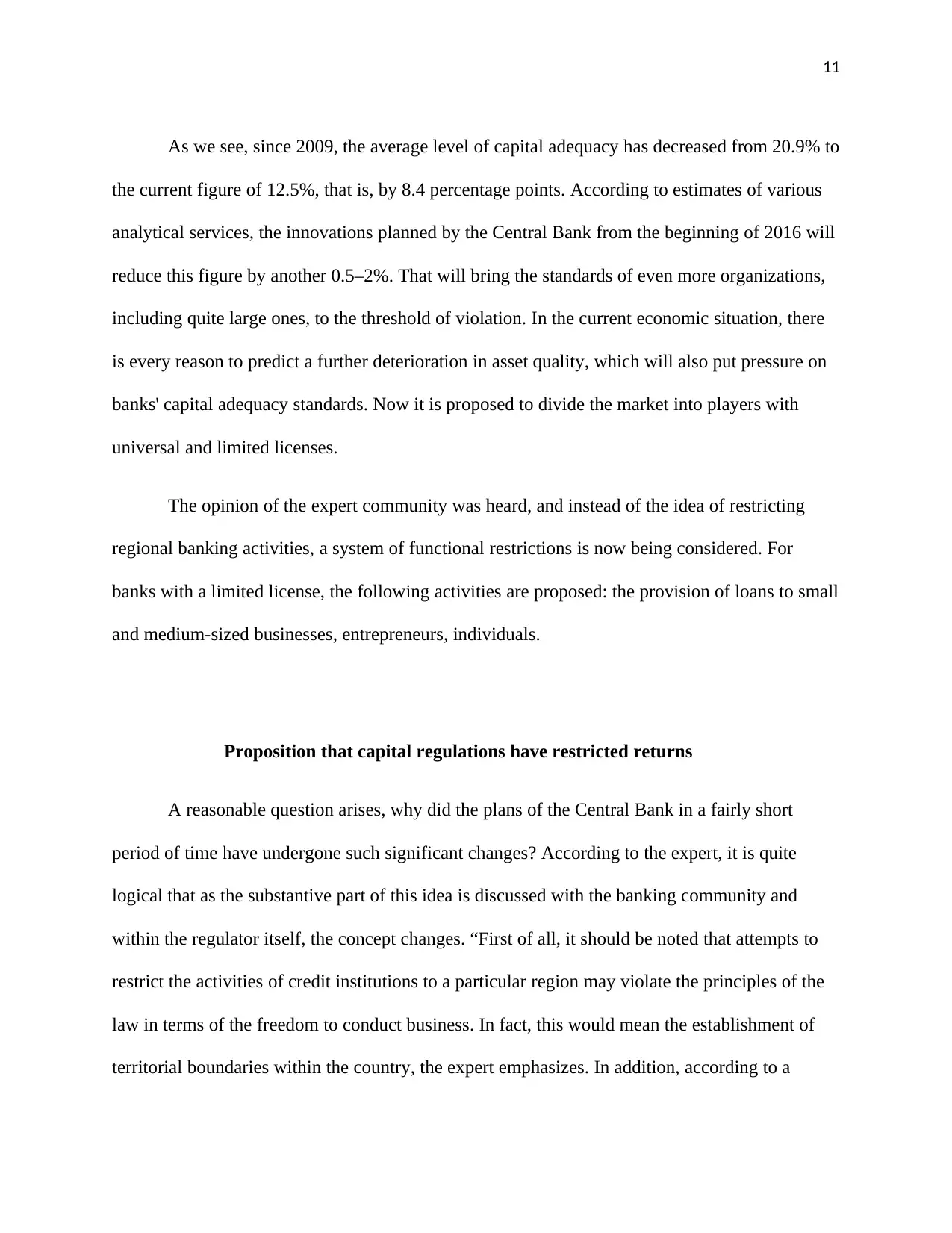
11
As we see, since 2009, the average level of capital adequacy has decreased from 20.9% to
the current figure of 12.5%, that is, by 8.4 percentage points. According to estimates of various
analytical services, the innovations planned by the Central Bank from the beginning of 2016 will
reduce this figure by another 0.5–2%. That will bring the standards of even more organizations,
including quite large ones, to the threshold of violation. In the current economic situation, there
is every reason to predict a further deterioration in asset quality, which will also put pressure on
banks' capital adequacy standards. Now it is proposed to divide the market into players with
universal and limited licenses.
The opinion of the expert community was heard, and instead of the idea of restricting
regional banking activities, a system of functional restrictions is now being considered. For
banks with a limited license, the following activities are proposed: the provision of loans to small
and medium-sized businesses, entrepreneurs, individuals.
Proposition that capital regulations have restricted returns
A reasonable question arises, why did the plans of the Central Bank in a fairly short
period of time have undergone such significant changes? According to the expert, it is quite
logical that as the substantive part of this idea is discussed with the banking community and
within the regulator itself, the concept changes. “First of all, it should be noted that attempts to
restrict the activities of credit institutions to a particular region may violate the principles of the
law in terms of the freedom to conduct business. In fact, this would mean the establishment of
territorial boundaries within the country, the expert emphasizes. In addition, according to a
As we see, since 2009, the average level of capital adequacy has decreased from 20.9% to
the current figure of 12.5%, that is, by 8.4 percentage points. According to estimates of various
analytical services, the innovations planned by the Central Bank from the beginning of 2016 will
reduce this figure by another 0.5–2%. That will bring the standards of even more organizations,
including quite large ones, to the threshold of violation. In the current economic situation, there
is every reason to predict a further deterioration in asset quality, which will also put pressure on
banks' capital adequacy standards. Now it is proposed to divide the market into players with
universal and limited licenses.
The opinion of the expert community was heard, and instead of the idea of restricting
regional banking activities, a system of functional restrictions is now being considered. For
banks with a limited license, the following activities are proposed: the provision of loans to small
and medium-sized businesses, entrepreneurs, individuals.
Proposition that capital regulations have restricted returns
A reasonable question arises, why did the plans of the Central Bank in a fairly short
period of time have undergone such significant changes? According to the expert, it is quite
logical that as the substantive part of this idea is discussed with the banking community and
within the regulator itself, the concept changes. “First of all, it should be noted that attempts to
restrict the activities of credit institutions to a particular region may violate the principles of the
law in terms of the freedom to conduct business. In fact, this would mean the establishment of
territorial boundaries within the country, the expert emphasizes. In addition, according to a
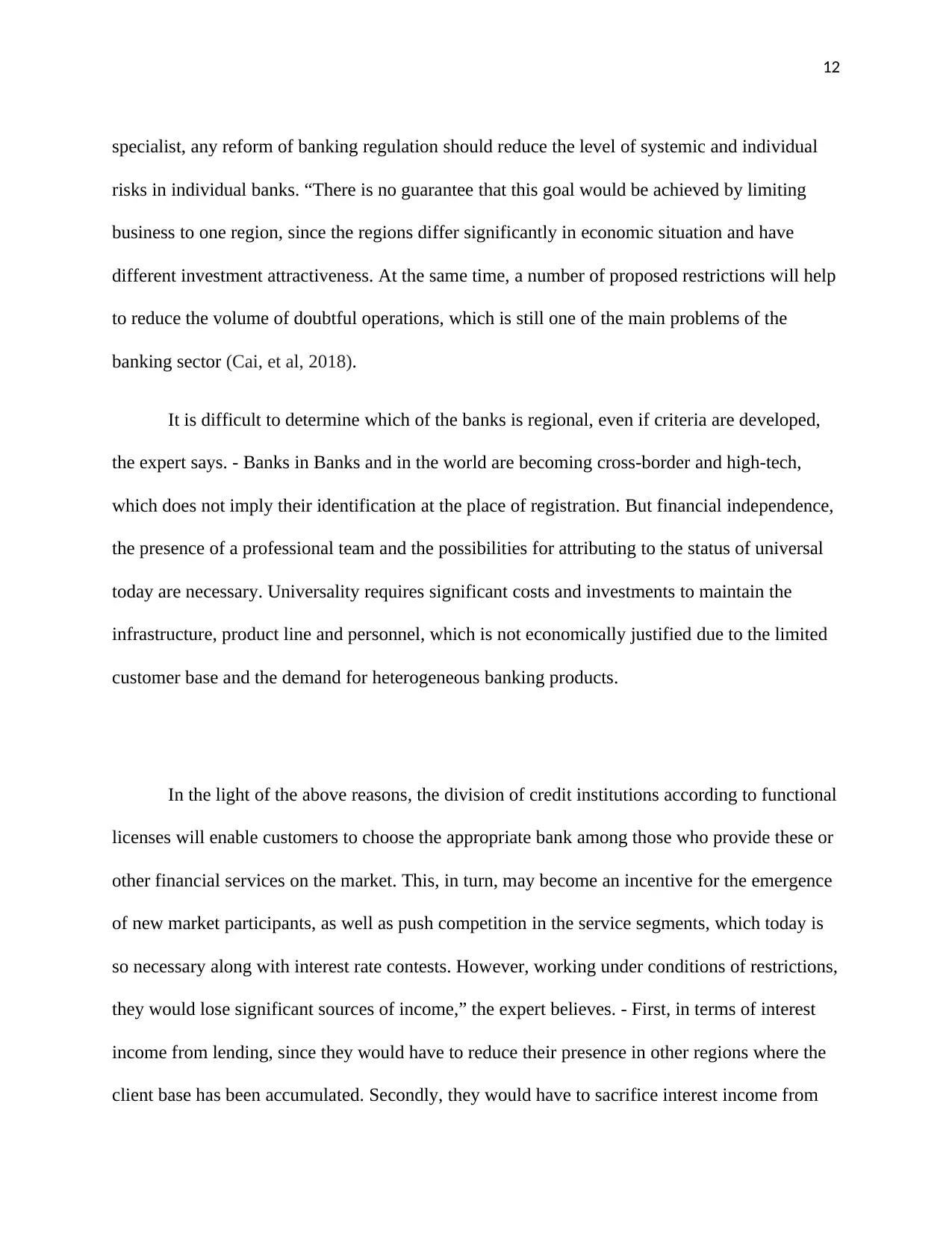
12
specialist, any reform of banking regulation should reduce the level of systemic and individual
risks in individual banks. “There is no guarantee that this goal would be achieved by limiting
business to one region, since the regions differ significantly in economic situation and have
different investment attractiveness. At the same time, a number of proposed restrictions will help
to reduce the volume of doubtful operations, which is still one of the main problems of the
banking sector (Cai, et al, 2018).
It is difficult to determine which of the banks is regional, even if criteria are developed,
the expert says. - Banks in Banks and in the world are becoming cross-border and high-tech,
which does not imply their identification at the place of registration. But financial independence,
the presence of a professional team and the possibilities for attributing to the status of universal
today are necessary. Universality requires significant costs and investments to maintain the
infrastructure, product line and personnel, which is not economically justified due to the limited
customer base and the demand for heterogeneous banking products.
In the light of the above reasons, the division of credit institutions according to functional
licenses will enable customers to choose the appropriate bank among those who provide these or
other financial services on the market. This, in turn, may become an incentive for the emergence
of new market participants, as well as push competition in the service segments, which today is
so necessary along with interest rate contests. However, working under conditions of restrictions,
they would lose significant sources of income,” the expert believes. - First, in terms of interest
income from lending, since they would have to reduce their presence in other regions where the
client base has been accumulated. Secondly, they would have to sacrifice interest income from
specialist, any reform of banking regulation should reduce the level of systemic and individual
risks in individual banks. “There is no guarantee that this goal would be achieved by limiting
business to one region, since the regions differ significantly in economic situation and have
different investment attractiveness. At the same time, a number of proposed restrictions will help
to reduce the volume of doubtful operations, which is still one of the main problems of the
banking sector (Cai, et al, 2018).
It is difficult to determine which of the banks is regional, even if criteria are developed,
the expert says. - Banks in Banks and in the world are becoming cross-border and high-tech,
which does not imply their identification at the place of registration. But financial independence,
the presence of a professional team and the possibilities for attributing to the status of universal
today are necessary. Universality requires significant costs and investments to maintain the
infrastructure, product line and personnel, which is not economically justified due to the limited
customer base and the demand for heterogeneous banking products.
In the light of the above reasons, the division of credit institutions according to functional
licenses will enable customers to choose the appropriate bank among those who provide these or
other financial services on the market. This, in turn, may become an incentive for the emergence
of new market participants, as well as push competition in the service segments, which today is
so necessary along with interest rate contests. However, working under conditions of restrictions,
they would lose significant sources of income,” the expert believes. - First, in terms of interest
income from lending, since they would have to reduce their presence in other regions where the
client base has been accumulated. Secondly, they would have to sacrifice interest income from
⊘ This is a preview!⊘
Do you want full access?
Subscribe today to unlock all pages.

Trusted by 1+ million students worldwide
1 out of 18
Related Documents
Your All-in-One AI-Powered Toolkit for Academic Success.
+13062052269
info@desklib.com
Available 24*7 on WhatsApp / Email
![[object Object]](/_next/static/media/star-bottom.7253800d.svg)
Unlock your academic potential
Copyright © 2020–2025 A2Z Services. All Rights Reserved. Developed and managed by ZUCOL.





